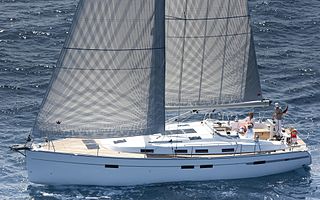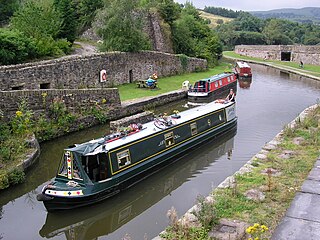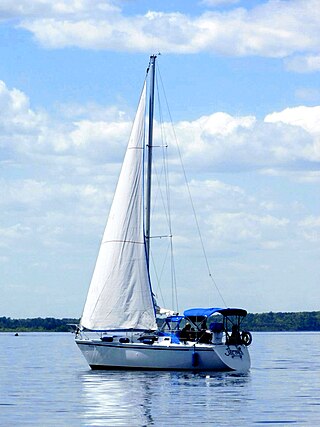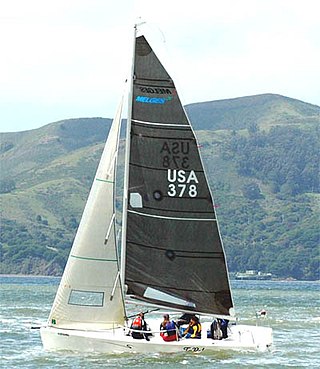
A boat is a watercraft of a large range of types and sizes, but generally smaller than a ship, which is distinguished by its larger size, shape, cargo or passenger capacity, or its ability to carry boats.

Cruising is a maritime activity that involves staying aboard a watercraft for extended periods of time when the vessel is traveling on water at a steady speed. Cruising generally refers to leisurely trips on yachts and luxury cruiseships, with durations varying from day-trips to months-long round-the-world voyages.

A yacht is a sailing or power vessel used for pleasure, cruising, or racing. There is no standard definition, though the term generally applies to vessels with a cabin intended for overnight use. To be termed a yacht, as opposed to a boat, such a pleasure vessel is likely to be at least 33 feet (10 m) in length and may have been judged to have good aesthetic qualities.

A narrowboat is a particular type of canal boat, built to fit the narrow locks of the United Kingdom. The UK's canal system provided a nationwide transport network during the Industrial Revolution, but with the advent of the railways, commercial canal traffic gradually diminished and the last regular long-distance transportation of goods by canal had virtually disappeared by 1970. However, some commercial traffic continued. From the 1970s onward narrowboats were gradually being converted into permanent residences or as holiday lettings. Currently, about 8580 narrowboats are registered as 'permanent homes' on Britain's waterway system and represent a growing alternative community living on semi-permanent moorings or continuously cruising.

Boating is the leisurely activity of travelling by boat, or the recreational use of a boat whether powerboats, sailboats, or man-powered vessels, focused on the travel itself, as well as sports activities, such as fishing or waterskiing. It is a popular activity, and there are millions of boaters worldwide.

A pocket cruiser is a sailboat designed for recreational cruising and club racing, under 30 feet (9 m) in length.

A superyacht or megayacht is a large and luxurious pleasure vessel. There are no official or agreed upon definitions for such yachts, but these terms are regularly used to describe professionally crewed motor or sailing yachts, ranging from 40 metres (130 ft) to more than 180 metres (590 ft) in length, and sometimes include yachts as small as 24 metres (79 ft).

A sailing yacht, is a leisure craft that uses sails as its primary means of propulsion. A yacht may be a sail or power vessel used for pleasure, cruising, or racing. There is no standard definition, so the term applies here to sailing vessels that have a cabin with amenities that accommodate overnight use. To be termed a "yacht", as opposed to a "boat", such a vessel is likely to be at least 33 feet (10 m) in length and have been judged to have good aesthetic qualities. Sailboats that do not accommodate overnight use or are smaller than 30 feet (9.1 m) are not universally called yachts. Sailing yachts in excess of 130 feet (40 m) are generally considered to be superyachts.

A trailer sailer is a type of sailboat that has been designed to be easily transported using a boat trailer towed by an automobile. They are generally larger than a sailing dinghy. Trailer sailers include day sailers and small cabin cruisers, suitable for living on.

The term sportsboat first appeared in the late 1980s and early 1990s to describe trailer sailers that were optimised for high performance at the expense of accommodation and ballast. The very definition of the term "sportsboat" is evolving.
Caribbean Sailing Yachts (CSY) is a company which built heavy-displacement recreational sailboats built during the 1970s and 1980s in Tampa, Florida. CSY was one of the first companies to recognize the impending growth of the Caribbean charter industry and although the company went out of business in the early 1980s, the well-founded boats have continued to sail the world's oceans for the past four decades. CSY's unique script logo was imprinted on a brass companionway medallion, dishware, and trailerboard design.
An Ultra Light Displacement Boat is a term used to refer to a modern form of sailboat watercraft with limited displacement relative to the hull size. Principally manufactured from the mid 1970s through mid 1980s, these boats generally sit higher in the water allowing them to move faster in nearly all water types other than directly crashing into larger waves, upwind, where the momentum of the water slows the boat down due to their lighter weights. They are typically racer-cruiser and/or "trailer sailer" boats that are excellent for towing, due to their light weight. They typically have cabins, but are designed for racing, excellent low-wind characteristics, large sail plans, and to have decent weight of crew-members to control heeling of the boat under medium winds, and higher. While some have keel-stepped masts and are raced in oceans, ocean bays, or offshore, such as the Olson 30, most have deck-stepped masts and are typically more common inland and in lakes or limited or protected ocean environments due to the construction design of these boats, and to provide some level of comfort to the crew.
The possibility of further speed increase [...] will always attract ardent believers in their speed virtues, just as they have done in the past. The ULDB are, however, very capricious creatures in terms of performance. They may deliver the goods, provided there is just a right kind of wind and from the right direction to sail 'full and by'. And since weather is also capricious, the ULDB and weather seldom suit each other. 'Light displacement craft', Davidson remarked, 'are not new in principle'. For many centuries there have been canoes, proas and the like in the South Pacific and other places, with similar displacement in proportion to the sail area and hull length. Racing dinghies, or dinghy-like modern offshore racers, so common today, are typical examples of the same principle. In all instances the combination of the major design features: displacement, sail area, length and stability [i.e. —] power to carry sails effectively, is radically different from the combination found in the traditional seaworthy and wholesome yachts.

The C&C Custom 67 is a Canadian sailboat, that was designed by Robert W. Ball of C&C Yachts and was launched and named Archangel in September 1980. She remains the largest pleasureboat commission ever received by C&C, and epitomized a trend within C&C during the later 1970s and early 1980s toward more cruising-oriented designs under George Cuthbertson's direction, a trend best illustrated by the development of the Landfall series.
The Parker Dawson 26 is an American trailerable sailboat that was designed by Robert Finch as a cruiser and first built in 1972.
The Blazer 23 is a Canadian trailerable sailboat that was designed by Bruce Kirby as racer-cruiser and first built in 1988.
The Bremer 25 is an American trailerable sailboat that was designed by Mark Bremer as a racer-cruiser and first built in 1995.
The Capri 26 is an American trailerable sailboat that was designed by Frank W. Butler and Gerry Douglas as a cruiser-racer and first built in 1990.
The Fisher 25 or Fisher 25 MS is a British trailerable pilothouse sailboat that was designed by Wyatt and Freeman as a cruiser and first built in 1974.
The MacGregor 19, also called the PowerSailer 19, is an American trailerable sailboat that was designed by Roger MacGregor as a cruiser and first built in 1992.
The Mark 25 is an American trailerable sailboat that was designed by Canadian George Harding Cuthbertson, as one of the first works under his new design firm Motion Designs Limited after he left C&C Design. The boat was intended as a racer-cruiser and first built in 1984.











